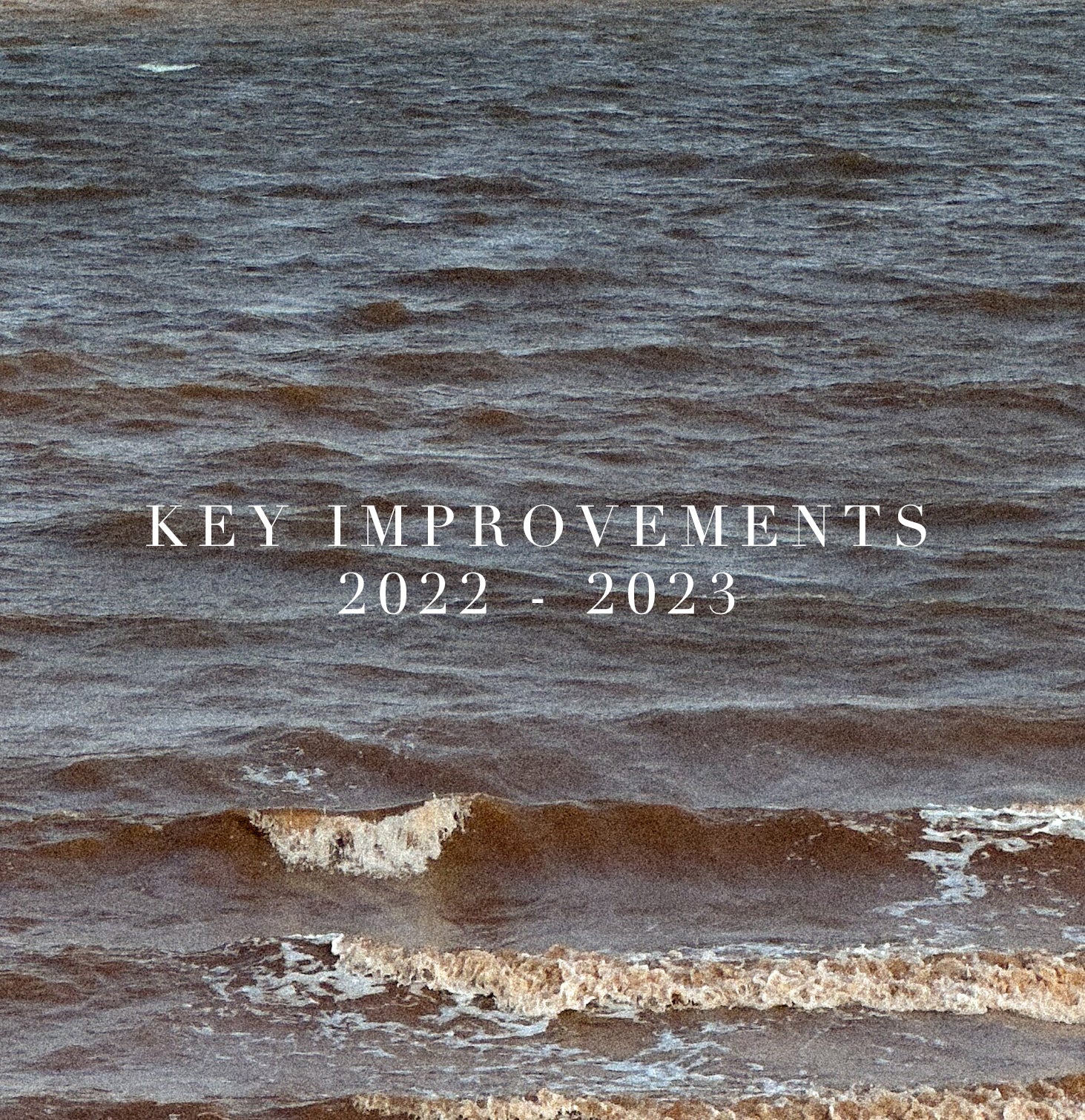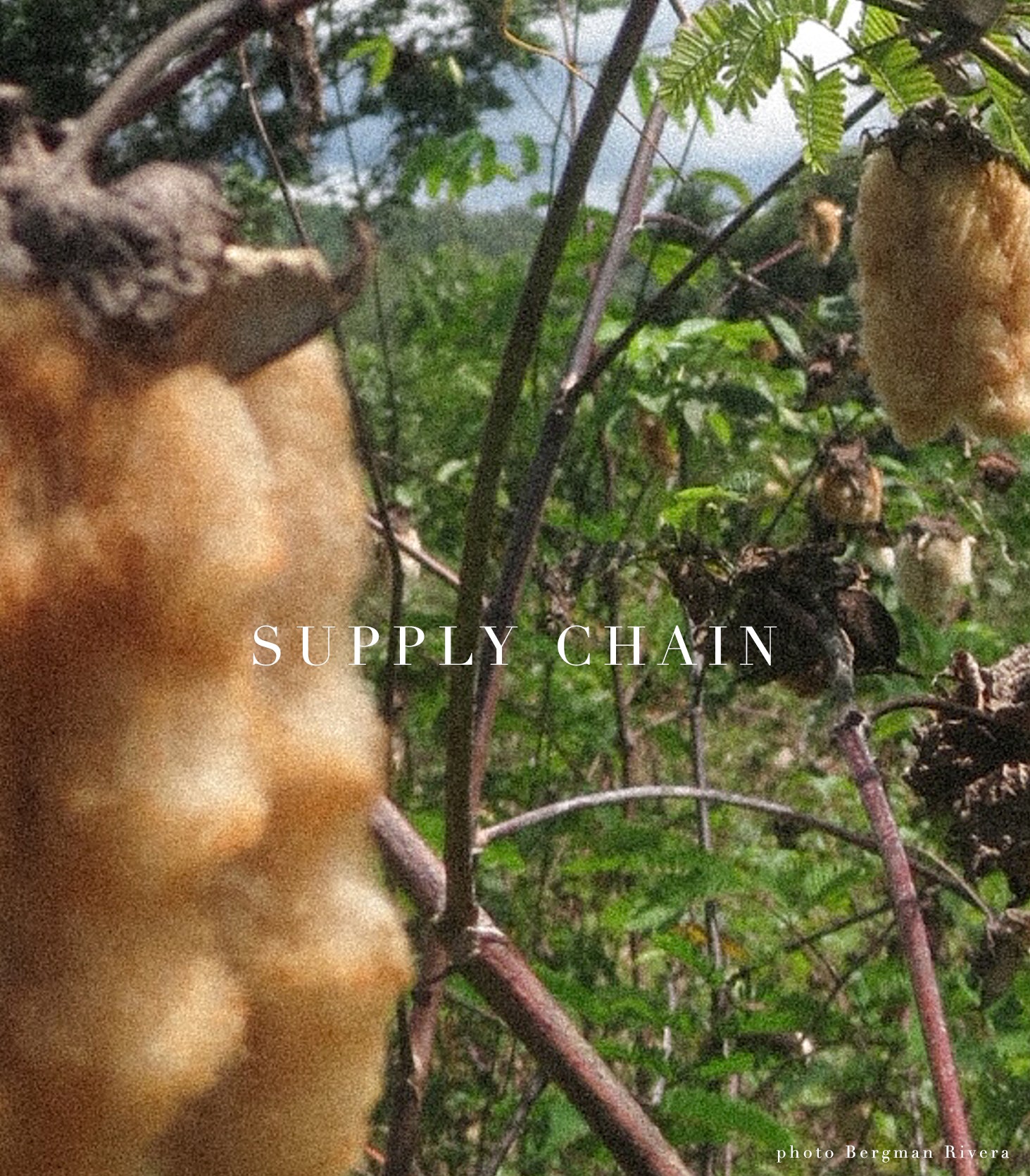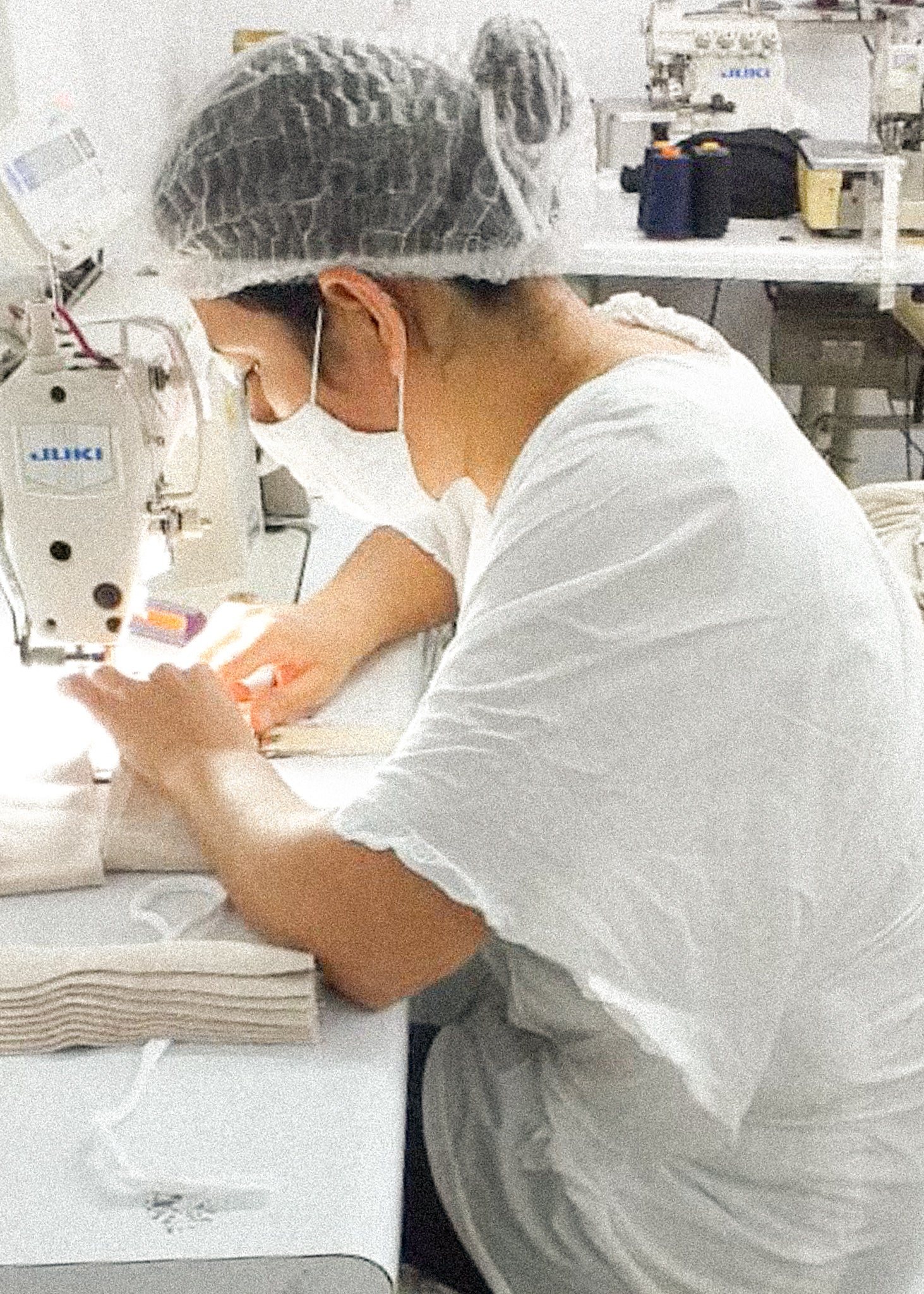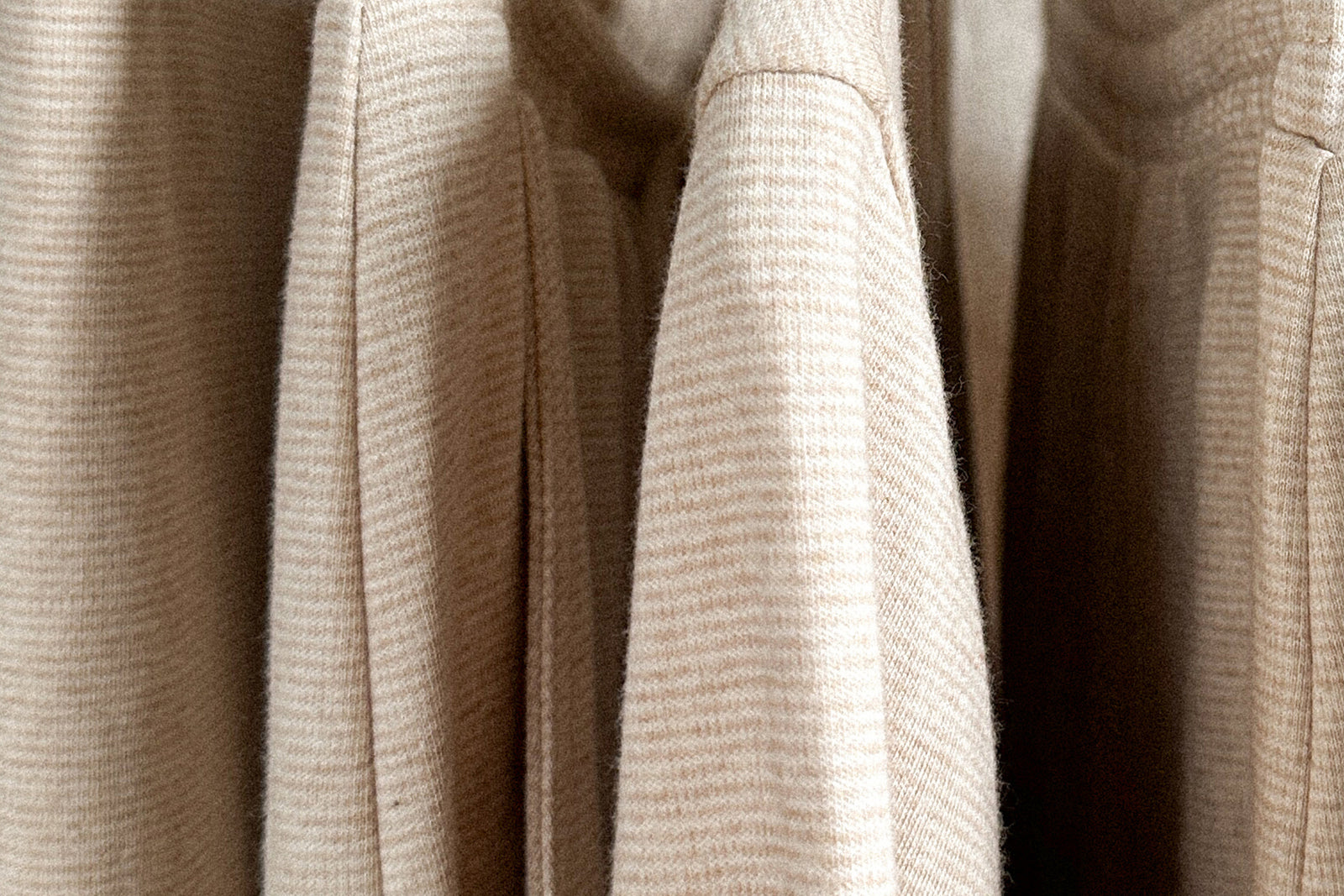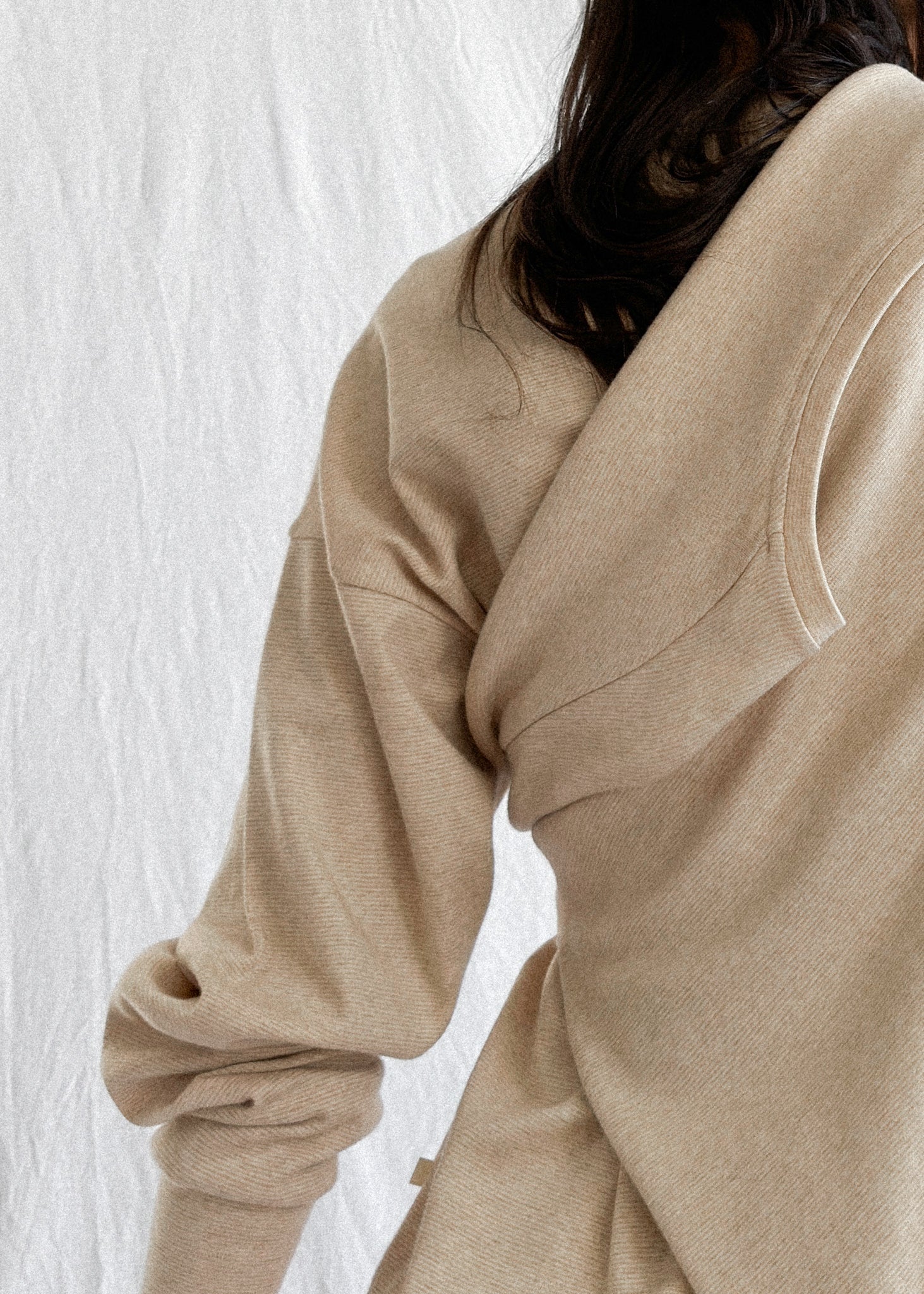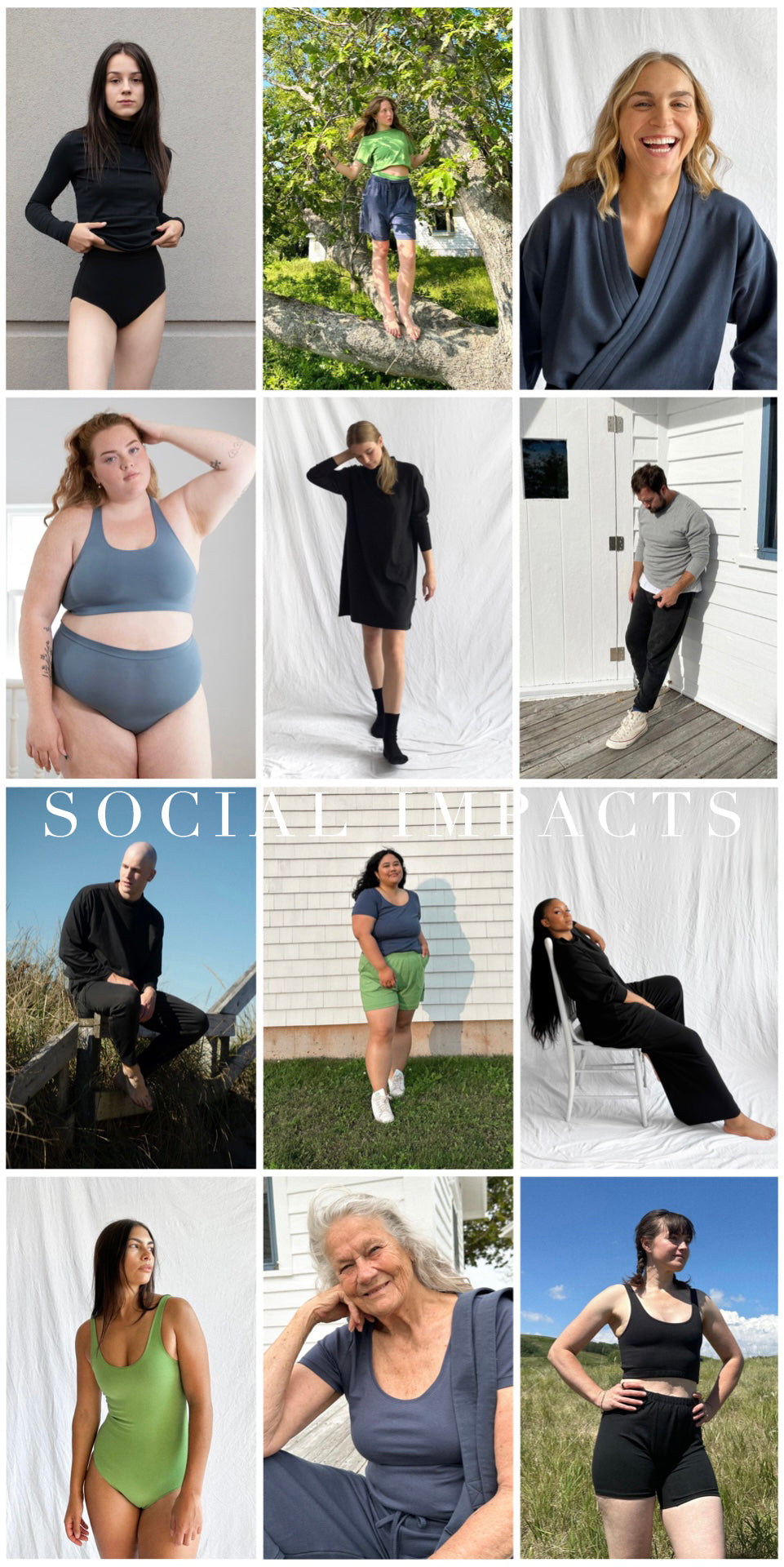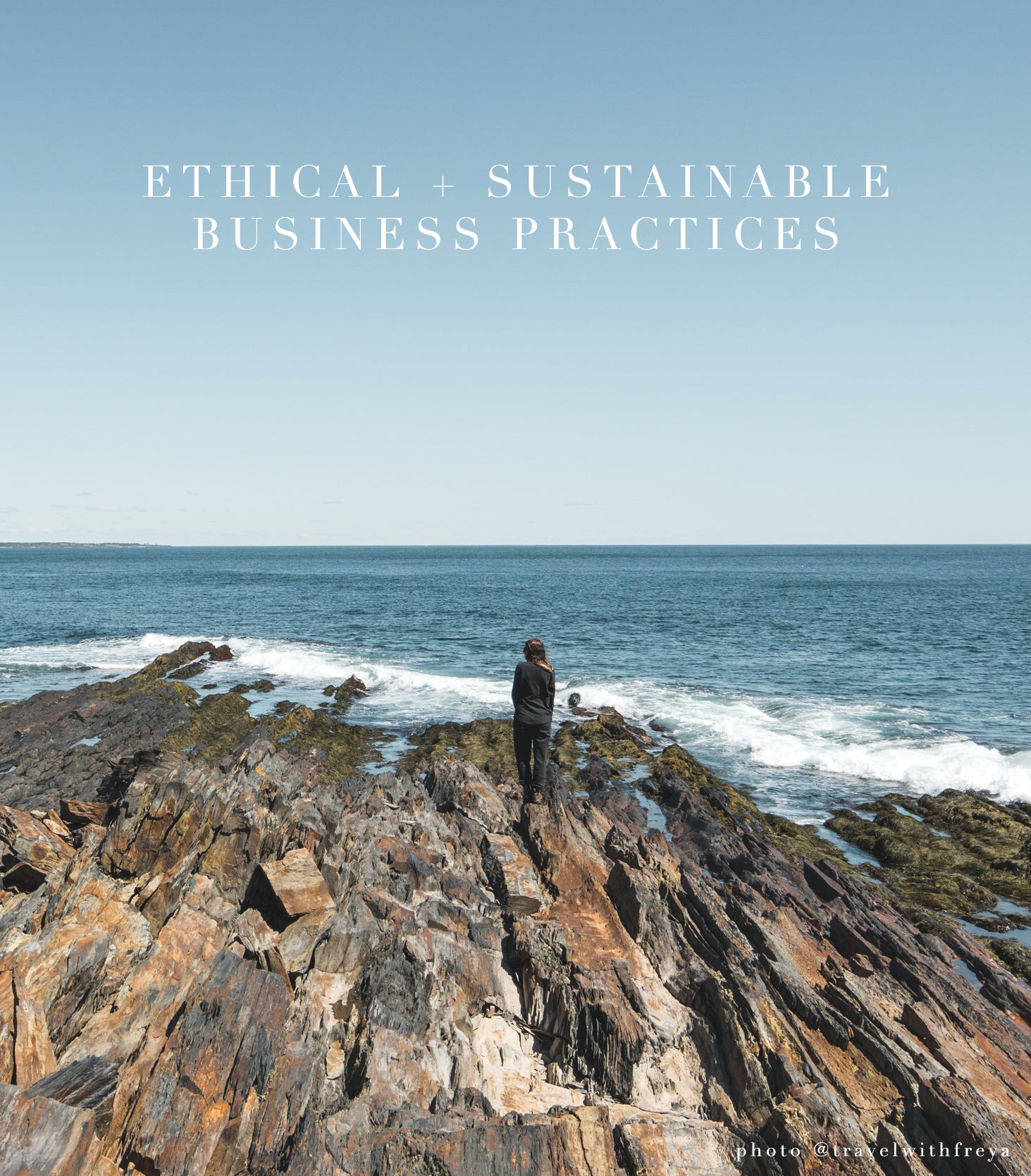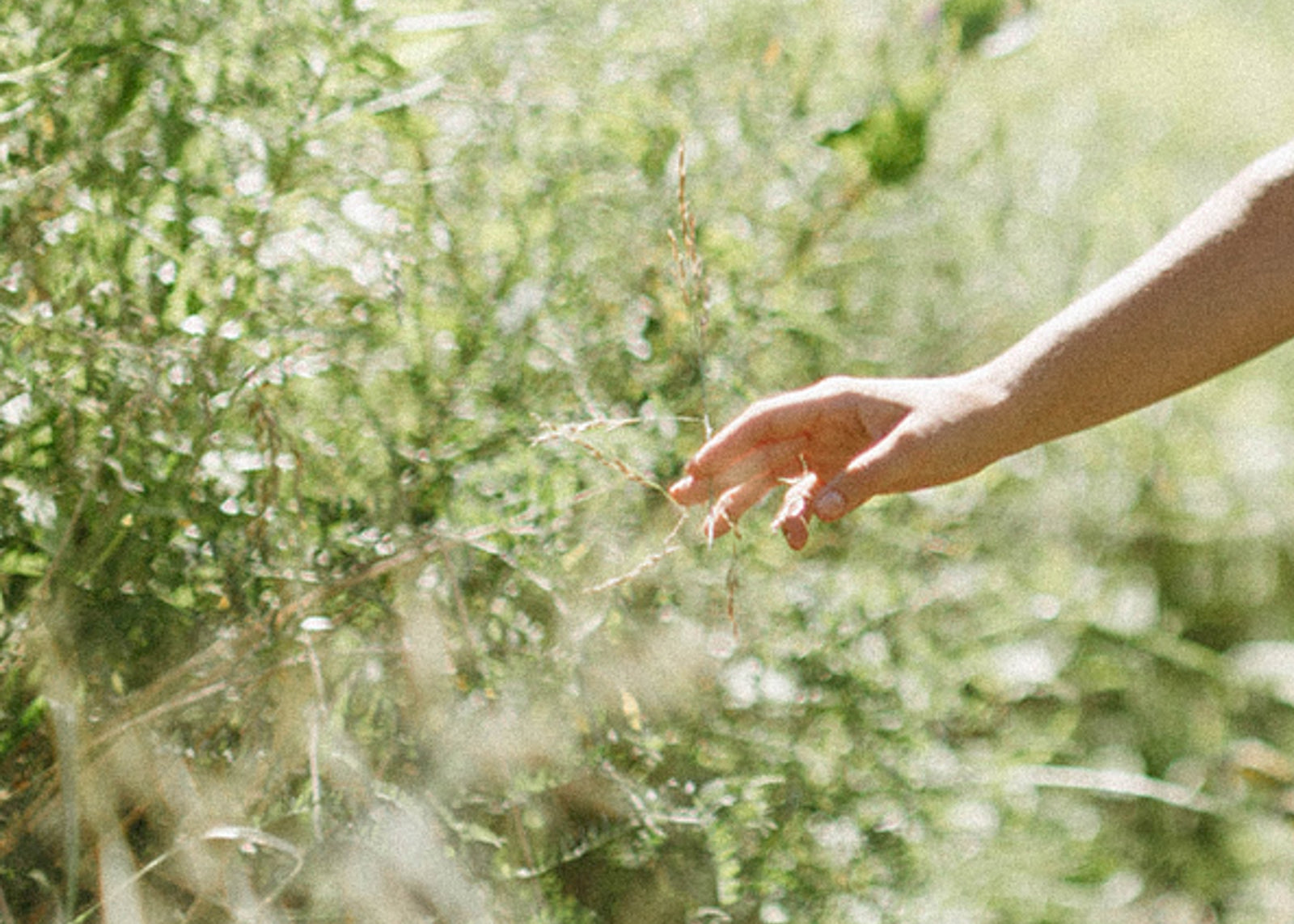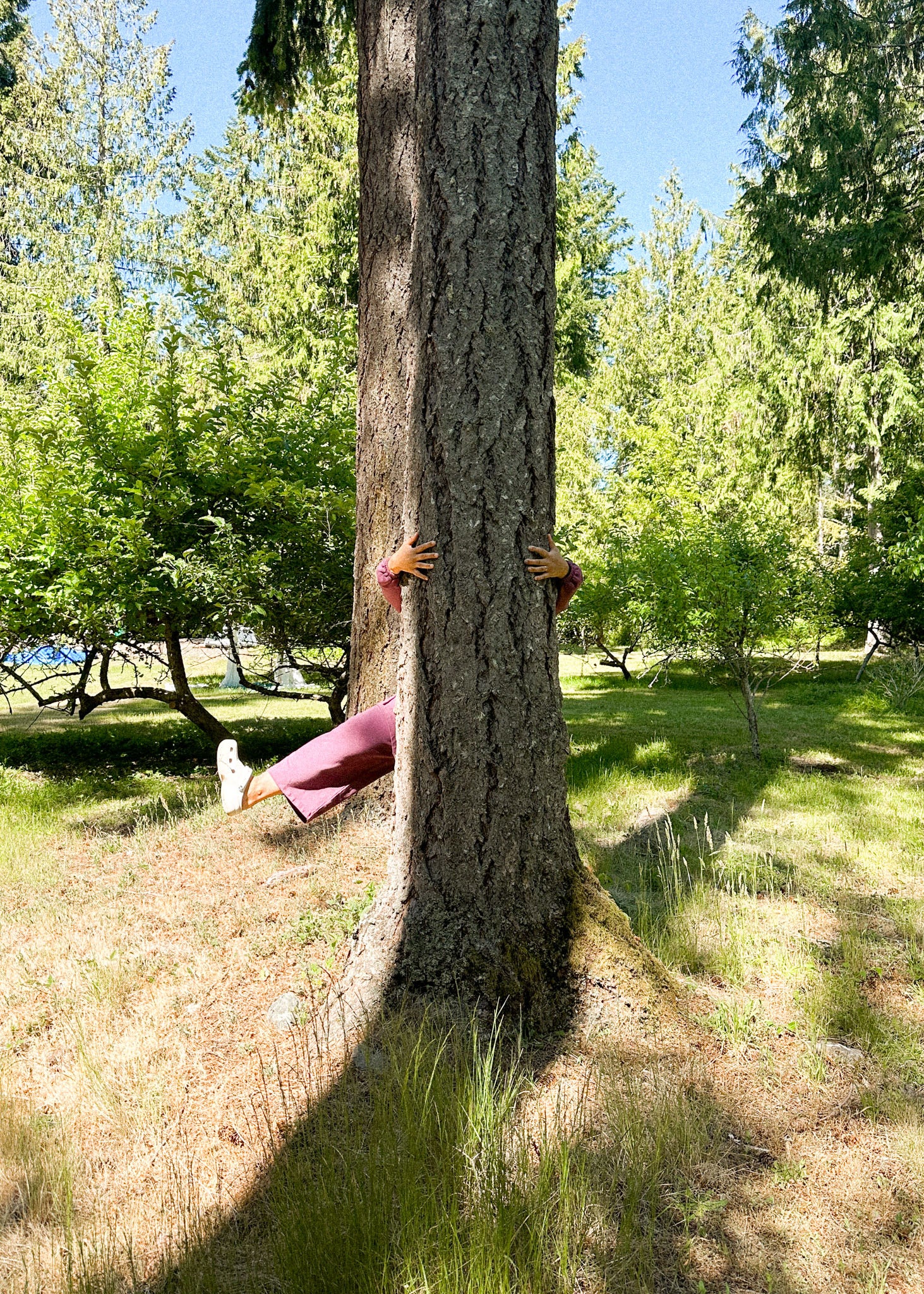Ana + Zac launched in 2019 and since the beginning both goals of sustainability and transparency have been at the forefront of our decision-making processes. Sustainable fashion can seem like an oxymoron given the rapid and ever-changing notion of fashion that we all know. New trends, different seasons, the latest items. Overconsumption is deeply ingrained in fashion; however, we have consistently tried to challenge this practice in the way we design, develop and market our clothing.
When we started working on this Impact Report in the Spring of 2023, we wanted to reflect on our commitment to sustainability and ensure we set a strong foundation for reporting on our journey. We have taken our time working on this report and have reached out to our manufacturers to gather more in-depth information. We have also had conversations with those who work within sustainability to help us gain insight. Researching, disseminating, and compiling this report in a slow manner has helped us throughout 2023 to make better choices with regards to our sustainability goals.
We view sustainability as a journey as it can continuously be worked upon and improved. We look back to the beginning of our brand and recognize the improvements we have made over the last four years, and we also see where there are places to improve.
This report is broken down into several sections which we have identified as the most relevant and impactful for our business. These include: Our Key Improvements from 2022 and 2023, Product Sustainability, Supply Chain, Materials and Innovation, Social Impacts, Ethical and Sustainable Business Practices, and our Sustainability Goals for 2024 and 2025.
Ana + Zac launched in 2019 and since the beginning both goals of sustainability and transparency have been at the forefront of our decision-making processes. Sustainable fashion can seem like an oxymoron given the rapid and ever-changing notion of fashion that we all know. New trends, different seasons, the latest items. Overconsumption is deeply ingrained in fashion; however, we have consistently tried to challenge this practice in the way we design, develop and market our clothing.
When we started working on this Impact Report in the Spring of 2023, we wanted to reflect on our commitment to sustainability and ensure we set a strong foundation for reporting on our journey. We have taken our time working on this report and have reached out to our manufacturers to gather more in-depth information. We have also had conversations with those who work within sustainability to help us gain insight. Researching, disseminating, and compiling this report in a slow manner has helped us throughout 2023 to make better choices with regards to our sustainability goals.
We view sustainability as a journey as it can continuously be worked upon and improved. We look back to the beginning of our brand and recognize the improvements we have made over the last four years, and we also see where there are places to improve.
This report is broken down into several sections which we have identified as the most relevant and impactful for our business. These include: Our Key Improvements from 2022 and 2023, Product Sustainability, Supply Chain, Materials and Innovation, Social Impacts, Ethical and Sustainable Business Practices, and our Sustainability Goals for 2024 and 2025.
Between 2022 and 2023, we made several important decisions that have ultimately re-positioned our brand.
In late 2022, we decided to make a major change to our business model by closing our retail store and relocating our operations to a smaller studio/warehouse. We decided to start 2023 with a clear directive, focusing on our online presence. This change has resulted in a reduction of our carbon footprint by downsizing our warehouse square footage by approximately 75%. In turn we use less resources, supplies, utilities and have streamlined the number of products that we are selling.
Several of our most exciting improvements have been in product development. We have expanded our use of G.O.T.S (Global Organic Textile Standard) Pima cotton. This has been one of our goals for 2024 since we started the brand, and we are now committed to using only G.O.T.S cotton for all our products.
We have implemented a manufacturing plan with Bergman Rivera, a Swedish-Peruvian family-owned manufacturing company located in Lima, Peru. We have been working with Bergman Rivera more closely throughout 2022 and 2023 to develop a special collection of clothing made from wild grown native Peruvian cotton. You will learn more about this initiative further into the report.
Between 2022 and 2023, we made several important decisions that have ultimately re-positioned our brand.
In late 2022, we decided to make a major change to our business model by closing our retail store and relocating our operations to a smaller studio/warehouse. We decided to start 2023 with a clear directive, focusing on our online presence. This change has resulted in a reduction of our carbon footprint by downsizing our warehouse square footage by approximately 75%. In turn we use less resources, supplies, utilities and have streamlined the number of products that we are selling.
Several of our most exciting improvements have been in product development. We have expanded our use of G.O.T.S (Global Organic Textile Standard) Pima cotton. This has been one of our goals for 2024 since we started the brand, and we are now committed to using only G.O.T.S cotton for all our products.
We have implemented a manufacturing plan with Bergman Rivera, a Swedish-Peruvian family-owned manufacturing company located in Lima, Peru. We have been working with Bergman Rivera more closely throughout 2022 and 2023 to develop a special collection of clothing made from wild grown native Peruvian cotton. You will learn more about this initiative further into the report.
There are two fabrications we have used in the past that are not 100% certified organic, French terry made from conventional Pima and our 91/9 stretch organic Pima blend. Our French Terry will be fully organic moving forward but it is not possible with the stretch Pima blend because it contains 9% spandex. We recognized and have always been transparent that a portion of our products contained spandex which is a man-made petroleum based fabric. It didn’t feel sustainable or authentic, to be on a trajectory of going completely organic while still producing these products.
In the fall of 2023, we made the decision to discontinue production of our 91/9 blend and rethink how we could make underwear and other stretchy styles differently with 100% organic cotton. We will no longer use spandex or plastic tape (sewn in the seams) in any of our garments. The details count and we are committed to working within the set parameters of our sustainability goals.
Textiles account for approximately 9% of annual microplastic losses to the oceans. By sourcing and utilizing natural plant-based fibers we are decreasing the amount of microplastic pollution that makes its way into the water. Eventually a garment will reach the end of its life and the speed that it degrades back into the earth is imperative.
There are two fabrications we have used in the past that are not 100% certified organic, French terry made from conventional Pima and our 91/9 stretch organic Pima blend. Our French Terry will be fully organic moving forward but it is not possible with the stretch Pima blend because it contains 9% spandex. We recognized and have always been transparent that a portion of our products contained spandex which is a man-made petroleum based fabric. It didn’t feel sustainable or authentic, to be on a trajectory of going completely organic while still producing these products.
In the fall of 2023, we made the decision to discontinue production of our 91/9 blend and rethink how we could make underwear and other stretchy styles differently with 100% organic cotton. We will no longer use spandex or plastic tape (sewn in the seams) in any of our garments. The details count and we are committed to working within the set parameters of our sustainability goals.
Textiles account for approximately 9% of annual microplastic losses to the oceans. By sourcing and utilizing natural plant-based fibers we are decreasing the amount of microplastic pollution that makes its way into the water. Eventually a garment will reach the end of its life and the speed that it degrades back into the earth is imperative.
Sustainability originates in the design and sourcing processes. Our design process is both slow, purposeful, and conscious. We use several different strategies to help us develop future collections which include sourcing raw goods, investing in product development, listening to our customer feedback and revising previous styles to improve them while creating new styles that will stand the test of time.
Our brand is known for our high-quality basics and we take pride in our timeless designs. We are always working towards smarter design while staying ahead of the curve. We revisit previous styles to improve upon them and develop new styles in line with the market and the current needs of our customers. Our focus on quality helps us create long-lasting pieces allowing our customers to consume less and shop more sustainably.
We order multiple size samples during our development process rather than just one size sample to ensure that the piece fits and looks great on multiple bodies. This can be a more expensive process, however for us it is imperative to be as inclusive as we can afford to be.
Listening to our customers has played a huge part in our ability to design smarter and make the right decisions for future collections especially when it comes to selecting colour ways. Our fall and holiday ‘23 collections were heavily influenced by our customers' sentiment for more items available in Ash Black, which is our most popular neutral, and Berry Stripe, a cheerful and interesting look to balance out the black. Our customers can look forward to more neutrals in the future (neutrals tend to last longer in your closet as they work with every item) while enjoying something fun and unexpected in the mix.
During this year we focused on making more matching sets. Sets are more sustainable as we use the same fabric for all the pieces, limiting our fabric waste and allowing for smarter consumption. These matching sets allow us to create small capsule collections where all the pieces work together mixed and matched.
By making our clothing with small boutique manufacturers, we can place orders with smaller minimums as well as have higher quality control standards resulting in a product of excellent craftsmanship which results in a longer life for the garment. Our collections are developed prior but ordered right before the cut off time - meaning we wait to see what customer sentiment is before we order so we can make the right decisions based on previous sales. Ordering a year in advance is industry standard but for us we bypass the fashion calendar resulting in a better sell through. Occasionally, we offer a pre-order on certain products and only order what there is demand for, thus, limiting any overproduction.
Sustainability originates in the design and sourcing processes. Our design process is both slow, purposeful, and conscious. We use several different strategies to help us develop future collections which include sourcing raw goods, investing in product development, listening to our customer feedback and revising previous styles to improve them while creating new styles that will stand the test of time.
Our brand is known for our high-quality basics and we take pride in our timeless designs. We are always working towards smarter design while staying ahead of the curve. We revisit previous styles to improve upon them and develop new styles in line with the market and the current needs of our customers. Our focus on quality helps us create long-lasting pieces allowing our customers to consume less and shop more sustainably.
We order multiple size samples during our development process rather than just one size sample to ensure that the piece fits and looks great on multiple bodies. This can be a more expensive process, however for us it is imperative to be as inclusive as we can afford to be.
Listening to our customers has played a huge part in our ability to design smarter and make the right decisions for future collections especially when it comes to selecting colour ways. Our fall and holiday ‘23 collections were heavily influenced by our customers' sentiment for more items available in Ash Black, which is our most popular neutral, and Berry Stripe, a cheerful and interesting look to balance out the black. Our customers can look forward to more neutrals in the future (neutrals tend to last longer in your closet as they work with every item) while enjoying something fun and unexpected in the mix.
During this year we focused on making more matching sets. Sets are more sustainable as we use the same fabric for all the pieces, limiting our fabric waste and allowing for smarter consumption. These matching sets allow us to create small capsule collections where all the pieces work together mixed and matched.
By making our clothing with small boutique manufacturers, we can place orders with smaller minimums as well as have higher quality control standards resulting in a product of excellent craftsmanship which results in a longer life for the garment. Our collections are developed prior but ordered right before the cut off time - meaning we wait to see what customer sentiment is before we order so we can make the right decisions based on previous sales. Ordering a year in advance is industry standard but for us we bypass the fashion calendar resulting in a better sell through. Occasionally, we offer a pre-order on certain products and only order what there is demand for, thus, limiting any overproduction.
Global supply chains can be mysterious, vast, and opaque. Having a short supply chain allows us to trace our roots and provide transparency. For the past five years we have been working with Raintex, a small vertically integrated boutique textile and clothing manufacturer based in Lima, Peru. Our supply chain in Peru is not only vertically integrated from yarn to garment, but it also comprises a short distance from raw to finished goods, therefore utilizing less energy consumption and carbon output until our products are flown to Canada.
Pima cotton fibers are grown, picked, and ginned by family-owned farms in proximity to Lima. The fibers are transported to yarn spinning facilities in Lima run by our certified yarn suppliers. The quality yarns are then sent to our local dye house or machine woven into fabric by our manufacturer. Un-dyed ‘greige’ fabrics are sent to our associate dye house and then sent back to our manufacturer to be cut and sewn.
Our fabrics are developed and produced in facilities in the same district, with machines rented by our manufacturer and controlled and run by trained technicians. Our garments are cut in-house by our manufacturer, along with all sample sewing. Garment construction is currently outsourced locally and then checked for quality control and packed by our in-house technicians. We would like to gain more knowledge of this process and we hope to make a more in-depth supply chain tour as mentioned in our 2024-2025 goals below.
Global supply chains can be mysterious, vast, and opaque. Having a short supply chain allows us to trace our roots and provide transparency. For the past five years we have been working with Raintex, a small vertically integrated boutique textile and clothing manufacturer based in Lima, Peru. Our supply chain in Peru is not only vertically integrated from yarn to garment, but it also comprises a short distance from raw to finished goods, therefore utilizing less energy consumption and carbon output until our products are flown to Canada.
Pima cotton fibers are grown, picked, and ginned by family-owned farms in proximity to Lima. The fibers are transported to yarn spinning facilities in Lima run by our certified yarn suppliers. The quality yarns are then sent to our local dye house or machine woven into fabric by our manufacturer. Un-dyed ‘greige’ fabrics are sent to our associate dye house and then sent back to our manufacturer to be cut and sewn.
Our fabrics are developed and produced in facilities in the same district, with machines rented by our manufacturer and controlled and run by trained technicians. Our garments are cut in-house by our manufacturer, along with all sample sewing. Garment construction is currently outsourced locally and then checked for quality control and packed by our in-house technicians. We would like to gain more knowledge of this process and we hope to make a more in-depth supply chain tour as mentioned in our 2024-2025 goals below.
Once finished and packed in recycled plastic packaging that uses approximately 75% less plastic than industry standard, our deliveries are shipped to our warehouse in Lunenburg, Nova Scotia via Toronto straight from Lima. We import our clothing via air cargo flying an estimated 35,000 km with a total carbon emissions output of approximately 10,200 CO2. Currently we receive five cargo shipments from Peru per annum and often combine shipments as well as samples to reduce the amount of shipping. Our CO2 output will change over time, and we will continue to update those figures annually and will continue to work to offset our carbon footprint in the different ways we outline in this report.
In 2023 we packed orders in 100% compostable mailers, additionally we also packed orders in recycled plastic by re-using shipping materials that our clothing arrives in from Peru, keeping our packaging minimal and sustainable.
In the summer of 2023, we gave a statement of support to the Veer Voyage Project, which could be the first clean container ship to cross an ocean eliminating the use of fossil fuels. See our statement of support below:
“Human induced climate change is now affecting our earth at an alarmingly rapid rate. We know that importing and exporting industries like ours are contributing heavily to this crisis. Currently, there are no sustainable commercial transport options. If clean net zero shipping like Veer was available to us, we would 100% utilize it. We, at Ana + Zac would make the necessary internal changes regarding lead times and logistics that would be required to switch to clean transport. Humans can make the right choices now and how we proceed will dramatically change the course of life on earth as we know it. Funding Veer is one of those existential decisions that will help decide the fate of our planet.”
Once finished and packed in recycled plastic packaging that uses approximately 75% less plastic than industry standard, our deliveries are shipped to our warehouse in Lunenburg, Nova Scotia via Toronto straight from Lima. We import our clothing via air cargo flying an estimated 35,000 km with a total carbon emissions output of approximately 10,200 CO2. Currently we receive five cargo shipments from Peru per annum and often combine shipments as well as samples to reduce the amount of shipping. Our CO2 output will change over time, and we will continue to update those figures annually and will continue to work to offset our carbon footprint in the different ways we outline in this report.
In 2023 we packed orders in 100% compostable mailers, additionally we also packed orders in recycled plastic by re-using shipping materials that our clothing arrives in from Peru, keeping our packaging minimal and sustainable.
In the summer of 2023, we gave a statement of support to the Veer Voyage Project, which could be the first clean container ship to cross an ocean eliminating the use of fossil fuels. See our statement of support below:
“Human induced climate change is now affecting our earth at an alarmingly rapid rate. We know that importing and exporting industries like ours are contributing heavily to this crisis. Currently, there are no sustainable commercial transport options. If clean net zero shipping like Veer was available to us, we would 100% utilize it. We, at Ana + Zac would make the necessary internal changes regarding lead times and logistics that would be required to switch to clean transport. Humans can make the right choices now and how we proceed will dramatically change the course of life on earth as we know it. Funding Veer is one of those existential decisions that will help decide the fate of our planet.”
Prior to 2024, we produced our clothing from either non-GMO conventional Pima cotton or G.O.T.S certified organic Pima cotton all grown and knitted in Peru. Organic Pima cotton is one of the rarest and highest quality strains of cotton in the world with a much longer fiber length than other types of cotton. The surface of Pima cotton is very soft and can last longer than the average natural textile surface if properly cared for.
We ask our customers to mind the washing instructions, like hand washing and lying flat to dry, to achieve a longer lasting life of their garment.
Throughout 2023, we increased our use of G.O.T.S Pima cotton. Prior to 2024, our mid-weight interlock and light weight jersey collections were made of 100% G.O.T.S Pima cotton and will continue to be. Our French terry fabric will now be made from G.O.T.S Pima cotton as well. As you have read above, we have discontinued our 91/9 spandex Pima blend to fall in line with our 2024 goal.
Prior to 2024, we produced our clothing from either non-GMO conventional Pima cotton or G.O.T.S certified organic Pima cotton all grown and knitted in Peru. Organic Pima cotton is one of the rarest and highest quality strains of cotton in the world with a much longer fiber length than other types of cotton. The surface of Pima cotton is very soft and can last longer than the average natural textile surface if properly cared for.
We ask our customers to mind the washing instructions, like hand washing and lying flat to dry, to achieve a longer lasting life of their garment.
Throughout 2023, we increased our use of G.O.T.S Pima cotton. Prior to 2024, our mid-weight interlock and light weight jersey collections were made of 100% G.O.T.S Pima cotton and will continue to be. Our French terry fabric will now be made from G.O.T.S Pima cotton as well. As you have read above, we have discontinued our 91/9 spandex Pima blend to fall in line with our 2024 goal.
Our yarns are dyed using OEKO-TEX certified dyes which are considered low impact and require much less water than the traditional dyes, as well as being the safer option for humans. Our clothing is finished in a non-toxic all-natural enzyme wash. This wash protects the fabric, increases the lifespan of the clothing, all while making the fabric even more soft to the touch.
Our clothing labels are low impact dyed and either printed on 100% cotton or on certified organic cotton. You may notice that they will start to fade over time, and this is because low impact dyes are water based and do not contain chemical fixatives.
We also add an extra cotton tab to secure our 100% recycled paper hang tags with cotton string rather than using plastic fasteners or safety pins.
We will continue to source rubber cotton elastic for our waistbands, and we are using 100% cotton in our zippers. We also use limited hardware and notions on our clothing and if we are using them, they are the best we can source such as YKK cotton zippers, the highest quality zipper available globally. This cuts down on malfunctions and breakage therefore extending the life of our garments. All these features help limit the excess waste from the final product.
Our yarns are dyed using OEKO-TEX certified dyes which are considered low impact and require much less water than the traditional dyes, as well as being the safer option for humans. Our clothing is finished in a non-toxic all-natural enzyme wash. This wash protects the fabric, increases the lifespan of the clothing, all while making the fabric even more soft to the touch.
Our clothing labels are low impact dyed and either printed on 100% cotton or on certified organic cotton. You may notice that they will start to fade over time, and this is because low impact dyes are water based and do not contain chemical fixatives.
We also add an extra cotton tab to secure our 100% recycled paper hang tags with cotton string rather than using plastic fasteners or safety pins.
We will continue to source rubber cotton elastic for our waistbands, and we are using 100% cotton in our zippers. We also use limited hardware and notions on our clothing and if we are using them, they are the best we can source such as YKK cotton zippers, the highest quality zipper available globally. This cuts down on malfunctions and breakage therefore extending the life of our garments. All these features help limit the excess waste from the final product.
We have been working closely with our suppliers to increase our use of organic Pima cotton. Organic farming maintains the health of the soil making it more resilient to extreme weather, such as droughts. Peru has seen a sharp increase in droughts and prolonged dry periods in recent years making it essential to promote the use and manufacturing of organic cotton and Peru’s native wild cotton.
In early 2024, we will release our first collection made with 100% Peruvian color grown wild cotton. Wild cotton is blended with organic undyed Pima cotton for the softest highest quality cotton clothing in the world. All of these garments will have natural undyed organic labels and will not contain any chemicals like pesticides, dyes, or plastics.
Bergman Rivera started the Wild Cotton project in 1994 in collaboration with the Peruvian Government. This was to “promote alternative crops to replace coca leaf plantations in the rainforest.” Native Peruvian cotton is special because of its enzymatic capacity that causes it to grow in a variety of different colors, such as natural white, cream, and brown. These native strains require far less irrigation and soil maintenance and can be rotated with lucrative crops like Organic Sacha Inchi and Organic Cacao, which helps increase the income for these family run farms. Native cotton almost went extinct due to the demand for traditional white cotton, but this program has kick started the rejuvenation of wild cotton and has consistently increased the production yields year after year. We know that if there is an increased demand, production will expand making this raw material a viable source of income, therefore creating an economy built for a safe and sustainable future for farming in Peru.
Also, to note, the Peruvian government enacted a moratorium law prohibiting the entry and production of genetically modified organisms (GMOs) within its borders, which includes GMO seeds. This law was enacted to help promote and protect biodiversity, family farming and preserve important cultural ties to the land.
We have been working closely with our suppliers to increase our use of organic Pima cotton. Organic farming maintains the health of the soil making it more resilient to extreme weather, such as droughts. Peru has seen a sharp increase in droughts and prolonged dry periods in recent years making it essential to promote the use and manufacturing of organic cotton and Peru’s native wild cotton.
In early 2024, we will release our first collection made with 100% Peruvian color grown wild cotton. Wild cotton is blended with organic undyed Pima cotton for the softest highest quality cotton clothing in the world. All of these garments will have natural undyed organic labels and will not contain any chemicals like pesticides, dyes, or plastics.
Bergman Rivera started the Wild Cotton project in 1994 in collaboration with the Peruvian Government. This was to “promote alternative crops to replace coca leaf plantations in the rainforest.” Native Peruvian cotton is special because of its enzymatic capacity that causes it to grow in a variety of different colors, such as natural white, cream, and brown. These native strains require far less irrigation and soil maintenance and can be rotated with lucrative crops like Organic Sacha Inchi and Organic Cacao, which helps increase the income for these family run farms. Native cotton almost went extinct due to the demand for traditional white cotton, but this program has kick started the rejuvenation of wild cotton and has consistently increased the production yields year after year. We know that if there is an increased demand, production will expand making this raw material a viable source of income, therefore creating an economy built for a safe and sustainable future for farming in Peru.
Also, to note, the Peruvian government enacted a moratorium law prohibiting the entry and production of genetically modified organisms (GMOs) within its borders, which includes GMO seeds. This law was enacted to help promote and protect biodiversity, family farming and preserve important cultural ties to the land.
At Ana + Zac, we promote diversity and inclusivity. The majority of our line is non-gendered and made up of styles that are easy to wear and comfortable. In our marketing we strive to show a diverse and representational array of models in terms of age, shape, and ethnicity. We do not follow body trends in our marketing and aim to be consistent in maintaining this every season.
We currently offer a size range from XS to 2XL (0 - 18/20). We have wanted to increase our size range to encompass more bodies, however, for a small brand like us it is expensive to expand. Offering this size range is what we can comfortably handle at this time. We understand that this is a limitation for our brand, and we want to be transparent about why we haven’t increased our size range. However, as our business continues to grow, we remain committed to investigating opportunities to expand our size offerings.
We work to educate our customers to improve their own sustainability practices and aim to promote conscious consumerism. For instance, we do not offer automatic free shipping or free returns. We help guide our customers to make informed decisions rather than allow for mindless consumption and unnecessary shipping. We include a sizing standard and detailed size charts on our website as well as providing images of multiple and diverse body types to aid in making the correct selection regarding sizing and fit to limit on the number of returns and minimize unnecessary shipping. We have a live chat available on our website so customers can speak to us directly so they can feel confident they are making informed decisions. Our shipping and return policies are intentional and help to put responsibility on both us and our customer to think consciously.
Sustainable fashion is more expensive than traditional fast fashion. We have inclusive and realistic pricing for our products. We often put on promotions to make our clothing more accessible and attainable throughout the year.
Because Pima cotton is very soft this has made our clothing more inclusive for people suffering from skin sensitivities and allergies. Our designs are meant to be easy to put on and take off for people with disabilities and we make deep pockets which have aided people who need to always carry something on them, like vital small sized medical equipment. We see the need for clothing that is soft on the body and easy to wear. We design for all people on every life path.
At Ana + Zac, we promote diversity and inclusivity. The majority of our line is non-gendered and made up of styles that are easy to wear and comfortable. In our marketing we strive to show a diverse and representational array of models in terms of age, shape, and ethnicity. We do not follow body trends in our marketing and aim to be consistent in maintaining this every season.
We currently offer a size range from XS to 2XL (0 - 18/20). We have wanted to increase our size range to encompass more bodies, however, for a small brand like us it is expensive to expand. Offering this size range is what we can comfortably handle at this time. We understand that this is a limitation for our brand, and we want to be transparent about why we haven’t increased our size range. However, as our business continues to grow, we remain committed to investigating opportunities to expand our size offerings.
We work to educate our customers to improve their own sustainability practices and aim to promote conscious consumerism. For instance, we do not offer automatic free shipping or free returns. We help guide our customers to make informed decisions rather than allow for mindless consumption and unnecessary shipping. We include a sizing standard and detailed size charts on our website as well as providing images of multiple and diverse body types to aid in making the correct selection regarding sizing and fit to limit on the number of returns and minimize unnecessary shipping. We have a live chat available on our website so customers can speak to us directly so they can feel confident they are making informed decisions. Our shipping and return policies are intentional and help to put responsibility on both us and our customer to think consciously.
Sustainable fashion is more expensive than traditional fast fashion. We have inclusive and realistic pricing for our products. We often put on promotions to make our clothing more accessible and attainable throughout the year.
Because Pima cotton is very soft this has made our clothing more inclusive for people suffering from skin sensitivities and allergies. Our designs are meant to be easy to put on and take off for people with disabilities and we make deep pockets which have aided people who need to always carry something on them, like vital small sized medical equipment. We see the need for clothing that is soft on the body and easy to wear. We design for all people on every life path.
Ana + Zac has operated as an independent small business since 2019. We are proud at Ana + Zac to implement several policies and practices both internally and externally. We are an equal opportunity employer and pay a fair and competitive wage to our small team of employees.
Since we started our brand, we have been working with Raintex, operating under the Occupational Safety and Health Administration (OSHA) as set forth by the International Labour Organization (ILO). This international standard ensures the rights and safety of workers. Raintex employs female led teams of technicians and there is a strong presence of women in all managerial roles in the company.
For the past two years we have been working with Bergman Rivera, a Fair Trade, GOTS, USDA Organic, B-Corp and Regenerative Cotton certified company based in Lima, Peru. They work directly with farms helping them on their organic certification journey and they follow a very strict code of conduct under a multitude of guidelines, which due to customer demand, helps push the industry in the right direction. They are laying the groundwork for all manufacturers to improve their business practices.
By working with manufacturers that communicate what they are comfortable with, with what they can and cannot achieve, including lead times and costing, we know we are working on a healthy and sustainable level for our partners.
Ana + Zac has operated as an independent small business since 2019. We are proud at Ana + Zac to implement several policies and practices both internally and externally. We are an equal opportunity employer and pay a fair and competitive wage to our small team of employees.
Since we started our brand, we have been working with Raintex, operating under the Occupational Safety and Health Administration (OSHA) as set forth by the International Labour Organization (ILO). This international standard ensures the rights and safety of workers. Raintex employs female led teams of technicians and there is a strong presence of women in all managerial roles in the company.
For the past two years we have been working with Bergman Rivera, a Fair Trade, GOTS, USDA Organic, B-Corp and Regenerative Cotton certified company based in Lima, Peru. They work directly with farms helping them on their organic certification journey and they follow a very strict code of conduct under a multitude of guidelines, which due to customer demand, helps push the industry in the right direction. They are laying the groundwork for all manufacturers to improve their business practices.
By working with manufacturers that communicate what they are comfortable with, with what they can and cannot achieve, including lead times and costing, we know we are working on a healthy and sustainable level for our partners.
In late 2022, we downsized from a 3000 square foot retail store, warehouse and office in the city to an 800 square foot studio warehouse in a small town in which we reside as well. We can easily walk to work which has improved our mental health as well as decreasing our carbon output.
This move has drastically reduced our operations environmental footprint. We use less energy to run our business by being conscious of our consumption and not over-using resources. The building we occupy space in uses oil for heating and we offset that by using less energy such as keeping the heat low and wearing warm clothing in the winter. We open our windows for air flow and do not use air conditioners in the summer. We utilize natural light for our day-to-day activities. We also recycle everything from paper to plastics while composting all our food waste. Without a big store and space to manage, we have cut down on office and retail supplies. All these small improvements can add up to our energy consumption, waste management and overall carbon footprint. We are proud to say that smaller is always better for our earth.
In late 2022, we downsized from a 3000 square foot retail store, warehouse and office in the city to an 800 square foot studio warehouse in a small town in which we reside as well. We can easily walk to work which has improved our mental health as well as decreasing our carbon output.
This move has drastically reduced our operations environmental footprint. We use less energy to run our business by being conscious of our consumption and not over-using resources. The building we occupy space in uses oil for heating and we offset that by using less energy such as keeping the heat low and wearing warm clothing in the winter. We open our windows for air flow and do not use air conditioners in the summer. We utilize natural light for our day-to-day activities. We also recycle everything from paper to plastics while composting all our food waste. Without a big store and space to manage, we have cut down on office and retail supplies. All these small improvements can add up to our energy consumption, waste management and overall carbon footprint. We are proud to say that smaller is always better for our earth.
While we are continuously sourcing and developing products that meet our sustainability goals, we are also committed to looking into ways to seek certifications for our business practices. B-Corp certification is widely recognized, but is not possible for us as we are currently not incorporated. We will always strive to improve our own practices and those of the manufacturers we employ.
We take transparency seriously and will work to strengthen our knowledge of our full supply chain by visiting Peru to do complete supply chain tours with both of our manufacturers. We will tour and document the organic and wild cotton farms and ginning processes. We will get to see how the yarns are spun from fibers, how our fabric is woven from those yarns, dyed, and finished and we will re-visit our clothing manufacturers. While we know our team of technicians very well and have toured some of the facilities on our previous visits, we feel these tours will better educate us and just as important, we will get to meet all the individuals involved. It is the people that make our clothing that are the most important, as without them we would have nothing. Concentrating on how we can positively affect their lives is a large part of why we do what we do.
Completing this Impact Report has been an important first step in identifying what questions we have with regards to our supply chain and where there are gaps in our knowledge. It is crucial for us to investigate and learn everything about these processes with both of our manufacturers. It is important for us to deepen our understanding of our brand’s impact and be able to improve upon any deficiencies.
While we are continuously sourcing and developing products that meet our sustainability goals, we are also committed to looking into ways to seek certifications for our business practices. B-Corp certification is widely recognized, but is not possible for us as we are currently not incorporated. We will always strive to improve our own practices and those of the manufacturers we employ.
We take transparency seriously and will work to strengthen our knowledge of our full supply chain by visiting Peru to do complete supply chain tours with both of our manufacturers. We will tour and document the organic and wild cotton farms and ginning processes. We will get to see how the yarns are spun from fibers, how our fabric is woven from those yarns, dyed, and finished and we will re-visit our clothing manufacturers. While we know our team of technicians very well and have toured some of the facilities on our previous visits, we feel these tours will better educate us and just as important, we will get to meet all the individuals involved. It is the people that make our clothing that are the most important, as without them we would have nothing. Concentrating on how we can positively affect their lives is a large part of why we do what we do.
Completing this Impact Report has been an important first step in identifying what questions we have with regards to our supply chain and where there are gaps in our knowledge. It is crucial for us to investigate and learn everything about these processes with both of our manufacturers. It is important for us to deepen our understanding of our brand’s impact and be able to improve upon any deficiencies.
Another exciting project on the horizon for Ana + Zac is our introduction of a circular program which we will call our archive collection. Creating a transparent circular economy for our clothing is one of the ways in which we can ensure we are responsible for our products after we sell them. We want to educate ourselves and our community about the benefits of a circular economy and give our clothing the longest lifespan possible. This is also a great way to increase accessibility to our products as gently used Ana + Zac clothing will be available at a discounted rate. A beta version of this program launches in January 2024.
Because we eliminated plastics from our clothing in 2023, we must rethink how we design some of our existing and future styles. We are designing with 100% natural fabric content and that poses challenges from a design perspective. From natural cotton zippers and cotton thread to styles that need stretch and durability in certain areas we are confident we can make clothing that looks great and lasts for years.
Looking forward, we are eager to pursue our sustainability journey and continue making a positive impact with the clothes we make.
At Ana + Zac, less is always more.
Thank you for reading this report and if you have any questions, please feel free to send us a message.
Another exciting project on the horizon for Ana + Zac is our introduction of a circular program which we will call our archive collection. Creating a transparent circular economy for our clothing is one of the ways in which we can ensure we are responsible for our products after we sell them. We want to educate ourselves and our community about the benefits of a circular economy and give our clothing the longest lifespan possible. This is also a great way to increase accessibility to our products as gently used Ana + Zac clothing will be available at a discounted rate. A beta version of this program launches in January 2024.
Because we eliminated plastics from our clothing in 2023, we must rethink how we design some of our existing and future styles. We are designing with 100% natural fabric content and that poses challenges from a design perspective. From natural cotton zippers and cotton thread to styles that need stretch and durability in certain areas we are confident we can make clothing that looks great and lasts for years.
Looking forward, we are eager to pursue our sustainability journey and continue making a positive impact with the clothes we make.
At Ana + Zac, less is always more.
Thank you for reading this report and if you have any questions, please feel free to send us a message.
